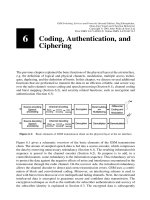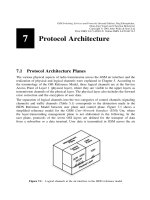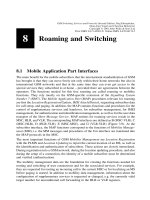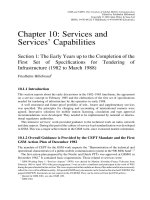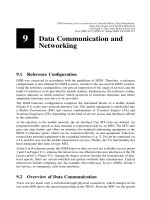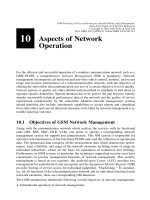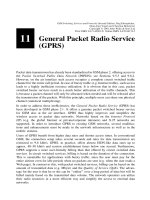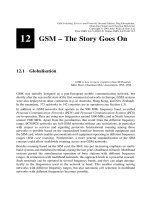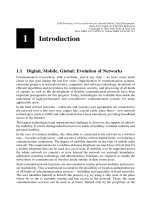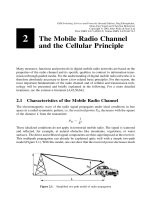GSM switching services and protocols P10
Bạn đang xem bản rút gọn của tài liệu. Xem và tải ngay bản đầy đủ của tài liệu tại đây (278.59 KB, 10 trang )
Aspects of Network
Operation
For the ef®cient and successful operation of a modern communication network such as a
GSM PLMN, a comprehensive Network Management (NM) is mandatory.Network
management encompasses all functions and activities which control, monitor, and record
usage and resource performance of a telecommunication network, with the objective of
offering the subscribers telecommunication services of a certain objective level of quality.
Various aspects of quality are either de®ned and prescribed in standards or laid down in
operator-speci®c de®nitions.Special attention has to be paid to the gap between (mostly
simple) measurable technical performance data of the network and the quality of service
experienced (subjectively) by the subscriber.Modern network management systems
should therefore also include (automated) capabilities to accept reports and complaints
from subscribers and convert them into measures to be taken by network management (e.g.
trouble ticketing systems).
10.1 Objectives of GSM Network Management
Along with the communication network which realizes the services with its functional
units (MS, BSS, MSC, HLR, VLR), one needs to operate a corresponding network
management system for support and administration.This NM system is responsible for
operation and maintenance of the functional PLMN units and the collection of operational
data.The operational data comprise all the measurement data which characterize perfor-
mance, load, reliability, and usage of the network elements, including times of usage by
individual subscribers, which are the basis for calculation of connection fees (billing).
Furthermore, in GSM systems in particular, the techniques supporting security must have
counterparts in security management functions of network management.This security
management is based on two registers: the Authentication Centre (AUC) provides key
management for authentication and encryption and the Equipment Identity Register (EIR)
provides barring of service access for individual equipment, ``blacklisting.'' To summar-
ize, for all functions of the telecommunication network and its individual functional units
(network elements), there are corresponding NM functions.
The GSM standard has de®ned the following overall objectives of network management:
² International operation of network management
10
GSM Switching, Services and Protocols: Second Edition. Jo
È
rg Eberspa
È
cher,
Hans-Jo
È
rg Vo
È
gel and Christian Bettstetter
Copyright q 2001 John Wiley & Sons Ltd
Print ISBN 0-471-49903-X Online ISBN 0-470-84174-5
² Cost limitation of GSM systems with regard to short-term as well as long-term aspects
² Achievement of service quality which at least matches the competing analog mobile
radio systems
The international operation of a GSM system includes among others the interoperability
with other GSM networks (including different countries) and with ISDN networks, as well
as the information exchange among network operators (billing, statistical data, subscriber
complaints, invalid IMEI etc.). These NM functions are in large part necessary for network
operation allowing international roaming of subscribers, and therefore they must be stan-
dardized.Their implementation is mandatory.
The costs of a telecommunication system consist of invested capital and operational costs.
The investments comprise the cost of the installation of the network and of the network
management, as well as development and licensing costs.The periodically incurred costs
include operation, maintenance, and administration as well as interest, amortization, and
taxes.Lost revenues due to failing equipment or partial or complete network failure must
be included in the periodically incurred costs, whereas consequential losses due to cases of
failure, e.g. because of lost customers, cannot be estimated and included. Therefore the
reliability and maintainability of the network equipment is of course of immense impor-
tance and heavily impacts costs.The installation of an NM system on one hand increases
the need for investment capital for the infrastructure as well as for spare capacities in the
network.On the other hand, these costs for a standardized comprehensive NM system must
be compared with the expenses for administration, operation, and maintenance of network
elements with manufacturer-proprietary management, or the costs which arise from not
recognizing and repairing network failures early enough.Therefore it has to be the objec-
tive of a cost-ef®cient NM system to de®ne and implement uniform vendor-independent
network management concepts and protocols for all network elements, and also to guar-
antee interoperability of network components from different manufacturers through
uniform interfaces within the network.
The quality of service to be achieved can be characterized with technical criteria like
speech quality, bit error ratio, network capacity, blocking probability, call disconnection
rates, supply probability, and availability, and it can also be characterized with nontech-
nical criteria like ease of operation and comfort of subscriber access or even hot-line and
support services.
Considering these objectives, the following functional areas for network management
systems can be identi®ed:
² Administrative and business area (subscribers, terminal equipment, charging, billing,
statistics)
² Security management
² Operation and performance management
² System version control
² Maintenance
These functions are realized in GSM based on the concept of the Telecommunication
Management Network (TMN).In general, they are summarized with the acronym
10 Aspects of Network Operation
232
FCAPS ± Fault, Con®guration, Accounting, Performance, and Security Management
(Figure 10.1).
Fault management includes functions like failure recognition, failure diagnosis, alarm
administration and ®ltering as well as capabilities for the identi®cation of causes of failures
or alarms and keeping of failure logs.Con®guration management administers network
con®gurations and handles changes, activates/deactivates equipment, and provides tools
for the automatic determination of network topology and connectivity.Accounting
management deals with the subscribers and is responsible for the establishment and
administration of subscriber accounts and service pro®les.Periodic billing for the indivi-
dual subscribers originates here, based on measured usage times and durations; statistics
are calculated, in certain circumstances only for network subareas (billing domains).In
performance management, one observes, measures, and monitors performance (through-
put, failure rates, response times, etc.), and utilization of network components (hardware
and software).The objective is on one hand to ensure a good utilization of resources and on
the other hand to recognize trends leading to overload and to be able to start counter-
measures early enough.Finally, security management provides for a thorough access
control, the authentication of subscribers, and an effective encryption of sensitive data.
10.2 Telecommunication Management Network (TMN)
TMN was standardized within ITU-T/ETSI/CEPT almost simultaneously with the pan-
European mobile radio system GSM.The guidelines of the M.series of the ITU-T (M.20,
M.30) serve as a framework.
TMN de®nes an open system with standardized interfaces.This standardization enables a
platform-independent multivendor environment for management of all components of a
telecommunication network.Essentially it realizes the communication of a management
system with network elements it administers, which are considered as managed objects.
These objects are abstract information models of the physical resources.A manager can
send commands to these administered objects over a standardized interface, can request or
change parameters, or be informed by the objects about events that occurred (noti®cation).
For this purpose, an agent resides in the managed object, which generates the management
messages or evaluates the requests from the manager, and maps them onto corresponding
10.2 Telecommunication Management Network (TMN)
233
Figure 10.1: Functional areas of TMN systems
operations or manipulations of the physical resources.This mapping is system speci®c as
well as implementation dependent and hence not standardized.The generalized architec-
ture of a TMN is illustrated in Figure 10.2.
The network management proper is realized in an Operation System (OS).The operation
systems represent the surveillance and control systems of a TMN system.These systems
can communicate with each other directly or form hierarchies.A standardized interface Q3
serves for the communication of the OSs within a TMN, whereas the interconnection of
two TMN systems occurs over the X interface (Figure 10.2). The management function-
ality can also be subdivided into several logical layers according to the OSI hierarchy.For
this approach, TMN provides the LogicalLayered Architecture (LLA) as a framework.
The exact numbering and corresponding functionality of each LLA plane were not yet
®nalized in the standardization process at the time of writing, however, the following
planes have been found to be useful (Figure 10.3): Business Management Layer (BML),
Service Management Layer (SML), Network Management Layer (NML), and Element
Management Layer (EML).
The TMN functions of the EML are realized by the network elements NE and contain basic
TMN functions such as performance data collection, alarm generation and collection, self
diagnosis, address conversion, and protocol conversion.Frequently, the EML is also
10 Aspects of Network Operation
234
Figure 10.2: TMN architecture (schematically, according to M.3010 [13])
known as a Network EML (NEML) or a Subnetwork Management Layer (SNML) [52].The
NML-TMN functions are normally performed by operation systems and used for the
realization of network management applications, which require a network-wide scope.
For this purpose, the NML receives aggregate data from the EML and generates a global
system view from them.On the SML plane, management activities are performed which
concern the subscriber and his or her service pro®le rather than physical network compo-
nents.The customer contact is administered in the SML, which includes functions like
establishing a subscriber account, initializing supplementary services, and several others.
The highest degree of abstraction is reached in the BML, which has the responsibility for
the total network operation.The BML supports strategic network planning and the coop-
eration among network operators [52].
For example, an operation system OS could act as a Basic OS and be in charge only of a
region with a subset of network elements, or it could be a Network OS which commu-
nicates with all the basic OSs and implements network-wide management functionality.
As a Service OS, an OS assumes network-wide responsibility for the management of one
service, whereas on the BML plane, care is taken of charging, billing, and administration
of the whole network and its services.
The individual functional units of the telecommunication network are mapped into
Network Elements (NEs).These elements are abstract representations of the physical
components of the telecommunication network, which is administered by this TMN.
The OSs communicate with the network elements over a comprehensive data network,
a Data Communication Network (DCN).For this purpose, an interface Q3 has been
de®ned, whose protocols comprise all seven layers of the OSI model.However, not
every network element must support the full range of Q3 interface capabilities.
For network elements whose TMN interface contains a reduced range of functionality
(Qx), a Mediation Device (MD) is interposed, which essentially performs the task of
protocol conversion between Qx and Q3.A mediator can serve several network elements
with incomplete Q3 interfaces, which can be connected to the mediator through a Local
Communication Network (LCN).The functions of a mediator are dif®cult to de®ne in
general and depend on the respective application, since the range of restrictions of a Qx
interface with regard to the Q3 interface is not standardized [23].Therefore, a mediator
could for example realize functions like data storage, ®ltering, protocol adaptation, or data
aggregation and compression.
10.2 Telecommunication Management Network (TMN)
235
Figure 10.3: Logical layered architecture of a TMN system
